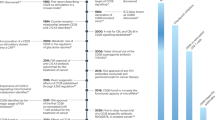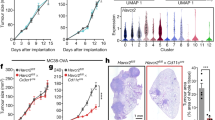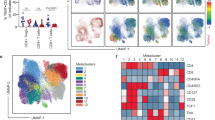Abstract
Engagement of the NKG2D receptor by tumour-associated ligands may promote tumour rejection by stimulating innate and adaptive lymphocyte responses1,2,3,4,5. In humans, NKG2D is expressed on most natural killer cells, γδ T cells and CD8αβ T cells1. Ligands of NKG2D include the major histocompatibility complex class I homologues MICA and MICB, which function as signals of cellular stress6,7. These molecules are absent from most cells and tissues but can be induced by viral and bacterial infections and are frequently expressed in epithelial tumours8,9,10,11. MIC engagement of NKG2D triggers natural killer cells and costimulates antigen-specific effector T cells1,10. Here we show that binding of MIC induces endocytosis and degradation of NKG2D. Expression of NKG2D is reduced markedly on large numbers of tumour-infiltrating and matched peripheral blood T cells from individuals with cancer. This systemic deficiency is associated with circulating tumour-derived soluble MICA, causing the downregulation of NKG2D and in turn severe impairment of the responsiveness of tumour-antigen-specific effector T cells. This mode of T-cell silencing may promote tumour immune evasion and, by inference, compromise host resistance to infections.
This is a preview of subscription content, access via your institution
Access options
Subscribe to this journal
Receive 51 print issues and online access
$199.00 per year
only $3.90 per issue
Buy this article
- Purchase on SpringerLink
- Instant access to full article PDF
Prices may be subject to local taxes which are calculated during checkout






Similar content being viewed by others
References
Bauer, S. et al. Activation of NK cells and T cells by NKG2D, a receptor for stress-inducible MICA. Science 285, 727–729 (1999)
Cerwenka, A., Baron, J. L. & Lanier, L. L. Ectopic expression of retinoic acid early inducible-1 gene (RAE-1) permits natural killer cell-mediated rejection of a MHC class I-bearing tumour in vivo. Proc. Natl Acad. Sci. USA 98, 11521–11526 (2001)
Diefenbach, A., Jensen, E. R., Jamieson, A. M. & Raulet, D. H. Rae1 and H60 ligands of the NKG2D receptor stimulate tumour immunity. Nature 413, 165–171 (2001)
Long, E. O. Tumor cell recognition by natural killer cells. Sem. Cancer Biol. 12, 57–61 (2002)
Pardoll, D. M. Stress, NK receptors, and immune surveillance. Science 294, 534–536 (2002)
Groh, V. et al. Cell stress-regulated human major histocompatibility complex class I gene expressed in gastrointestinal epithelium. Proc. Natl Acad. Sci. USA 93, 12445–12450 (1996)
Groh, V., Steinle, A., Bauer, S. & Spies, T. Recognition of stress-induced MHC molecules by intestinal epithelial γδ T cells. Science 279, 1737–1740 (1998)
Groh, V. et al. Broad tumour-associated expression and recognition by tumour-derived γδ T cells of MICA and MICB. Proc. Natl Acad. Sci. USA 96, 6879–6884 (1999)
Das, H. et al. MICA engagement by human Vγ2Vδ2 T cells enhances their antigen-dependent effector function. Immunity 15, 83–93 (2001)
Groh, V. et al. Costimulation of CD8 αβ T cells by NKG2D via engagement by MIC induced on virus-infected cells. Nature Immunol. 2, 255–260 (2001)
Tieng, V. et al. Binding of Escherichia coli adhesin AfaE to CD55 triggers cell-surface expression of the MHC class I-related molecule MICA. Proc. Natl Acad. Sci. USA 99, 2977–2982 (2002)
Linsley, P. S., Bradshaw, J., Urnes, M., Grosmaire, L. & Ledbetter, J. A. CD28 engagement by B7/BB-1 induces transient down-modulation of CD28 synthesis and prolonged unresponsiveness to CD28 signaling. J. Immunol. 150, 3161–3169 (1993)
Valitutti, S., Muller, S., Salio, M. & Lanzavecchia, A. Degradation of T cell receptor (TCR)–CD3-ζ complexes after antigenic stimulation. J. Exp. Med. 185, 1859–1864 (1997)
Huard, B. & Karlsson, L. KIR expression on self-reactive CD8+ T cells is controlled by T-cell receptor engagement. Nature 403, 325–328 (2000)
Li, P. et al. Complex structure of the actiavting immunoreceptor NKG2D and its MHC class I–like ligand MICA. Nature Immunol. 2, 443–451 (2001)
Steinle, A. et al. Interactions of human NKG2D with its ligands MICA and MICB and homologs of the mouse RAE-1 protein family. Immunogenetics 53, 279–287 (2001)
Wu, J. et al. An activating immmunoreceptor complex formed by NKG2D and DAP10. Science 285, 730–732 (1999)
Yee, C., Savage, P. A., Lee, P. P., Davis, M. M. & Greenberg, P. D. Isolation of high avidity melanoma-reactive CTL from heterogeneous populations using peptide-MHC tetramers. J. Immunol. 162, 2227–2234 (1999)
Schatz, P. J. Use of peptide libraries to map the substrate specificity of a peptide-modifying enzyme: A 13 residue consensus peptide specifies biotinylation in Escherichia coli. Biotechnology 11, 1138–1143 (1993)
Knappik, A. & Pluckthun, A. An improved affinity tag based on the FLAG peptide for detection and purification of recombinant antibody fragments. Biotechniques 17, 754–761 (1994)
Acknowledgements
We thank R. Rhinehart and K. Kenyon for technical assistance; H. Secrist, D. Byrd and R. Yeung for tissue materials; and S. Riddell for critically reading the manuscript. This work was supported by grants from the NIH.
Author information
Authors and Affiliations
Corresponding author
Ethics declarations
Competing interests
The authors declare that they have no competing financial interests.
Rights and permissions
About this article
Cite this article
Groh, V., Wu, J., Yee, C. et al. Tumour-derived soluble MIC ligands impair expression of NKG2D and T-cell activation. Nature 419, 734–738 (2002). https://doi.org/10.1038/nature01112
Received:
Accepted:
Issue Date:
DOI: https://doi.org/10.1038/nature01112
This article is cited by
-
MICA and NLRP3 gene polymorphisms interact synergistically affecting the risk of ankylosing spondylitis
Immunologic Research (2024)
-
Integration of single sample and population analysis for understanding immune evasion mechanisms of lung cancer
npj Systems Biology and Applications (2023)
-
Roles of natural killer cells in immunity to cancer, and applications to immunotherapy
Nature Reviews Immunology (2023)
-
Different effects of NK cells and NK-derived soluble factors on cell lines derived from primary or metastatic pancreatic cancers
Cancer Immunology, Immunotherapy (2023)
-
Compromised activity of natural killer cells in diffuse large b-cell lymphoma is related to lymphoma-induced modification of their surface receptor expression
Cancer Immunology, Immunotherapy (2023)



